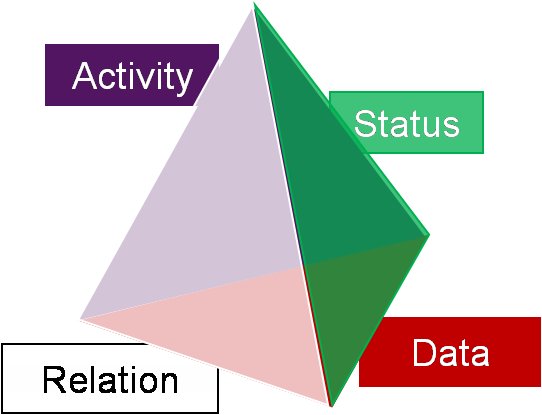In ARONTO all application functionality is built by modelling ready to use concepts which are part of an Enterprise Ontology. Concepts are data objects characterized by their name, their parameters and the relation to other concepts. Example: vehicle (brand, type, construction date…) driven by (relation) driver (name, license type, license number, date of issue…). It can be shown that about 400 concepts are enough to represent the main data objects of an enterprise. These 400 concepts build the ARONTO Enterprise Ontology. The concepts are connected and build a so called Knowledge Graph which is stored in a graph database. The relation is also a specific concept in ARONTO. If a concept is missing it’s easy to create a new one or adapt an existing one by changing name or a parameter. The Ontology is therefore flexible and open. But the ARONTO ontology has another specific characteristic. It contains two further specific concepts, namely activity and status following the Dov Dori theorem (Dov Dori professor at MIT Boston), that each dynamic system in the universe can be described with a conceptual model using four items: object, relation, activity, status. These are the four meta concepts. A sequence of activity and status is defining a process. The ARONTO Enterprise Ontology is therefore open, flexible and dynamic and enables also the modelling of processes.With the 400 concepts and their openness and flexibility every possible enterprise application can be modelled. This is a pure data-centric approach with one enduring data model in place, which is completely independent from the applications to be developed.
Basic modelling steps are the definition of the object concepts of an application, then defining the possible relation between the object concepts and then defining the process of each object concept (as a sequence of activity and status) linking to the related object concept.
concept: ontologic model of an object characterized by
- Data attributes and constraints
- Behaviour dynamic = status + activity
Relations to other concepts

The result is an application specific knowledge graph model stored in the ARONTO graph database. This model is directly executable by the ARONTO finite state machine. The model is also the specification and the documentation.
The user interface is generated automatically.
To design the application specific knowledge graph ARONTO is using a graphical tool, the hyperbolic tree. It enables to design and show a total application on one screen using zooming capabilities.
ARONTO Platform Functionality

Building a domain ontology through conceptual modelling
Conceptual modelling:
A concept is a set of formal definitions.

[ name ]
[ attributes, constraints]
[ possible relation to other concepts, constraints]
[ dynamic behaviour (activity, status) ]
ontology:
is the aggregate of concepts of a knowledge domain

ARONTO delivers an open, flexible and dynamic enterprise ontology consisting of about 400 concepts
ARONTO Platform Components

ARONTO Development Studio: Hyperbolic Tree


